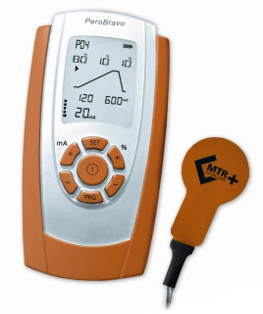Stimulation of paretic muscles
If any patient suffers by paresis the nerves that activate a muscle or group of muscles are disturbed for various reasons. The deliberate contraction of the muscle is not possible anymore and the muscle is inactive. Due to this inactivity, the number of active muscle fibers will reduce and the muscle mass will decrease within a few weeks (atrophy).
The use of electrical stimulation is helpful:
- to avoid or delay muscle atrophy in the phase of nerve-regeneration
- to accelerate the nervous facilitation by intention-exercises and positive feedback
- to perform rehabilitative muscle training according to the physical condition or to do purposeful gait training using a footswitch in case of progressed recovery.
The initial treatment usually consists of long single pulses in a triangular or trapezoidal shape (exponential current), as the paretic muscle does not respond well to the usual short rectangular pulses of normal muscle stimulation. The length of ascent ensures a reaction of the paretic muscle and helps to avoid the contraction of the surrounding healthy muscles (selective stimulation). In the regeneration phase of the nerve, muscular atrophy shall be prevented or at least retarded by repetitions of short single twitches.
One of the most common kinds of palsy is peronaeus-paralysis or foot-dorsiflexion. The peroneal nerve activates the muscles needed for lifting the foot. If the nerves are disconnected to the muscles by accident or disease, we name it denervation. If it’s only disturbed, we use the term “partial denervated muscles” (peroneal palsy).
As soon as the muscle responds to rectangular pulses, it is possible to start the second phase of treatment with normal muscle training by short biphasic rectangular pulses in a certain frequency and using work and rest periods. At this stage, gait-training can start as well. It is supported by a foot-switch that triggers current for the swing-phase of the step. An adjustable delay-time allows gait-synchronous stimulation.
This way the peroneal treatment can be divided into four different sections:
- Creation of a strength/duration-curve (SDC) to measure the degree of the problem
- Stimulation with long triangular or trapezoidal single pulses to avoid muscle atrophy
- Training of the disturbed nerve-muscle-system by current with longer biphasic rectangular pulses – the length of the pulses can decrease more and more
- Gait-training by current with short rectangular pulses – assisted by a footswitch
Older devices for peroneal treatment often support only one of these four sub-areas, so that big units in clinics, at doctors or physiotherapists had to be used to create the SD-curve. Often three different stimulators were required in the home therapy to cover the areas 2-4. PeroBravo now allows – according to the instructions of the physician or therapist – home therapy from the very beginning up to the end.